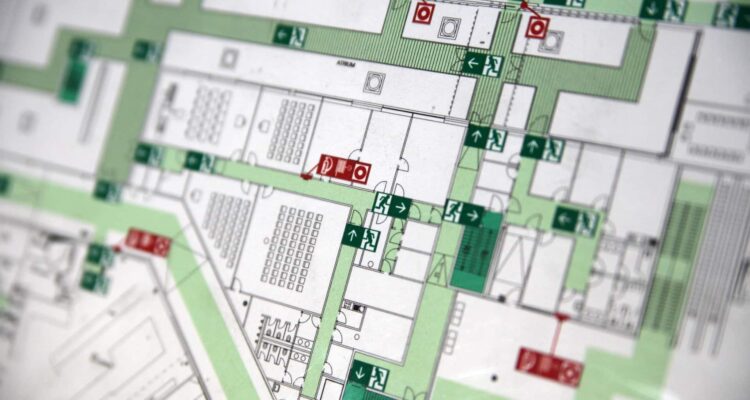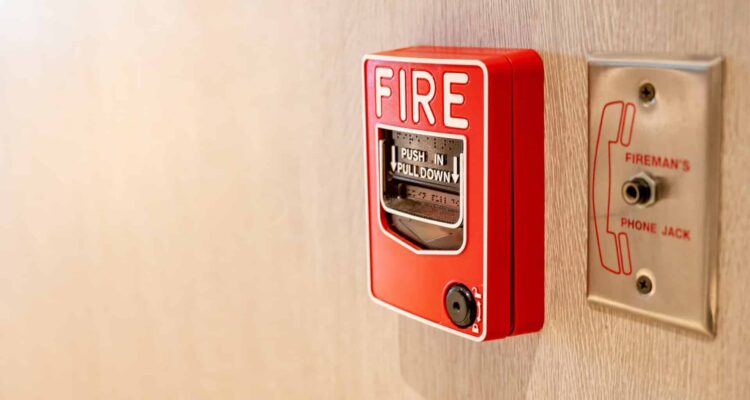In the current business environment, deploying commercial fire safety solutions transcends regulatory compliance. It is…

How to Develop a Fire Evacuation Plan for Your Business
A fire breaking out in your workplace is a serious concern. It can lead to the disruption of your business, financial losses, and in a worst-case scenario, loss of life. While a fire itself is dangerous enough, the threat can be compounded by chaos and panic if your business is unprepared.
The best way to prevent this and ensure everyone gets out of the building safely is to have a fire evacuation plan in place. If you don’t have one, here are seven steps you can take to build one.
- A report from the U.S. Fire Administration listed 116,500 fires in nonresidential buildings in 2021, resulting in losses of $3.7 billion.
Step 1: Imagine Various Scenarios
When creating your fire evacuation plan, begin by considering the fire-related threats your business may face.
How do fires break out? The leading cause of nonresidential fires is cooking fires. Other fires result from electrical malfunctions, heating appliances, and arson. Understanding why most fires occur will help you establish fire risks specific to your business and prevent them.
What are your risks? Think about how a fire might break out on your premises. For instance…
- Do you have a kitchen in your building?
- Are people using portable space heaters?
- Do nearby wildfires threaten your location each summer?
Since fires caused by cooking are at the top of the list, establish rules for the use of kitchen appliances. Forbid electric grills, hot plates, and other cooking appliances outside the kitchen area.
Step 2: What If X Happens?
Develop a “What If X Happens?” list of questions and answers where X is as business-specific as possible. Consider scenarios such as…
- What if we have to abandon our premises with very little notice?
- What if we are evacuated and we have twelve refrigerated trucks loaded with our weekly ice cream deliveries?
Imagining different scenarios provides the basis for creating an action plan. This exercise also helps you make your employees aware of something no one has imagined and inserts fire preparedness into the collective consciousness.
Step 3: Establish Responsibilities
If a fire happens and everyone must evacuate, your employees need leaders to rely on for guidance. Therefore, it’s crucial to create a clear chain of command that establishes who has the authority to order an evacuation and who should take predetermined actions. Here are the primary roles to be considered as part of your fire evacuation plan:
- Chief Fire Warden — This person has the overall responsibility in the event of a fire. Duties will include ensuring doors are closed, checking bathrooms, and performing a headcount at a safe location.
- Assistant Fire Warden — This person’s job is to notify employees, call the fire department, and gather reports if your business uses an emergency communication system. In the latter case, this person needs to be a systems administrator.
- Route Guides — Route guides have the essential role of ensuring that evacuation routes are clear and evacuation is calm and orderly.
- Floor Monitors — These are the last persons to leave after making sure the area they are responsible for is clear. Their role is to ensure all employees are evacuating, close doors, and report back to the Chief Fire Warden.
- Disability Assistants — These individuals are responsible for helping employees with disabilities who may need additional assistance when evacuating.
Step 4: Determine Nearest Exits, Escape Routes, and Assembly Points
An effective fire evacuation plan should include primary and secondary escape routes. All exit routes and fire escapes should have clear signs posted on them. Exit routes should be kept clear of furniture, equipment, or any other objects that could impede a direct means of egress.
Designate a safe assembly point for employees to gather once they are out of the building. The Chief Fire Warden should take a headcount at the assembly point to ensure everyone is present.
There will inevitably be someone on vacation or out sick, so these people obviously won’t be at the rally point. To overcome this problem, the Chief Fire Warden should be given real-time daily access to a list of who has reported to work and who else is in the building, including contractors, temporary workers, and customers.
Step 5: Create a Communication Plan
Designate someone to disseminate information to key stakeholders, including employees, customers, and the news media. Also, determine whether your crisis communication plan should include suppliers, transportation partners, community outreach, or government officials.
Once you have assigned someone to this critical role, you need to provide them with an emergency multichannel communication system that is independent of your workplace facility. Reaction to fire is likely to be very chaotic, and access to regular communication channels may not be possible.
Step 6: Inspect Your Emergency Equipment
Have you bothered to inspect those dusty office fire extinguishers recently? The National Fire Protection Association recommendations include refilling reusable fire extinguishers every ten years and replacing disposable ones every twelve years.
In addition, you should periodically remind your employees about the location of fire extinguishers and train them in their proper use. Another important step is to establish a schedule for confirming that other emergency equipment is in good condition, up-to-date, and operable, including the following.
- Fire alarm and smoke alarm systems
- Carbon monoxide detectors
- Sprinkler systems
- Emergency lighting
- Fire doors (if applicable)
- Escape ladders (if applicable)
- Loudspeaker system for your Chief Fire Warden
Step 7: Practice Fire Evacuation Procedures
Conducting regular evacuation drills minimizes confusion and helps everyone understand how a safe fire evacuation happens. This will help to reduce panic if a real emergency occurs.
A fire can move quickly, and seconds could make a difference, so preparedness on an individual level is crucial. An additional benefit of regular fire drills is that they allow those people in fire safety leadership roles to practice their parts and other employees to recognize who those leaders are.
Your Fire Evacuation Plan: Final Thoughts
Your plan should be unique to your business and the workspace it is meant to serve. For example, if you have a multi-story office building, you will have a number of floors and several staircases to deal with. On the other hand, if you have a factory or a warehouse, you might have a single wide-open space and equipment to navigate around.
When you have a fire evacuation plan in place for your business, you’ve taken a huge step to prioritize fire safety and protect your employees. In addition, an inclusive evacuation plan can prepare your business for other emergencies, such as natural disasters and active shooter situations.
Your Commercial Fire Alarm System
Protection from fire starts with a top-of-the-line commercial fire alarm and security system, such as one provided by US Protective Services. We can provide your business with the latest heat, smoke, and flame detection devices that increase safety and cut down on false alarms. In addition, you also receive local 24/7 monitoring for fast dispatch of appropriate emergency services. Get in touch with us today for a free, no-obligation quote for your business!



